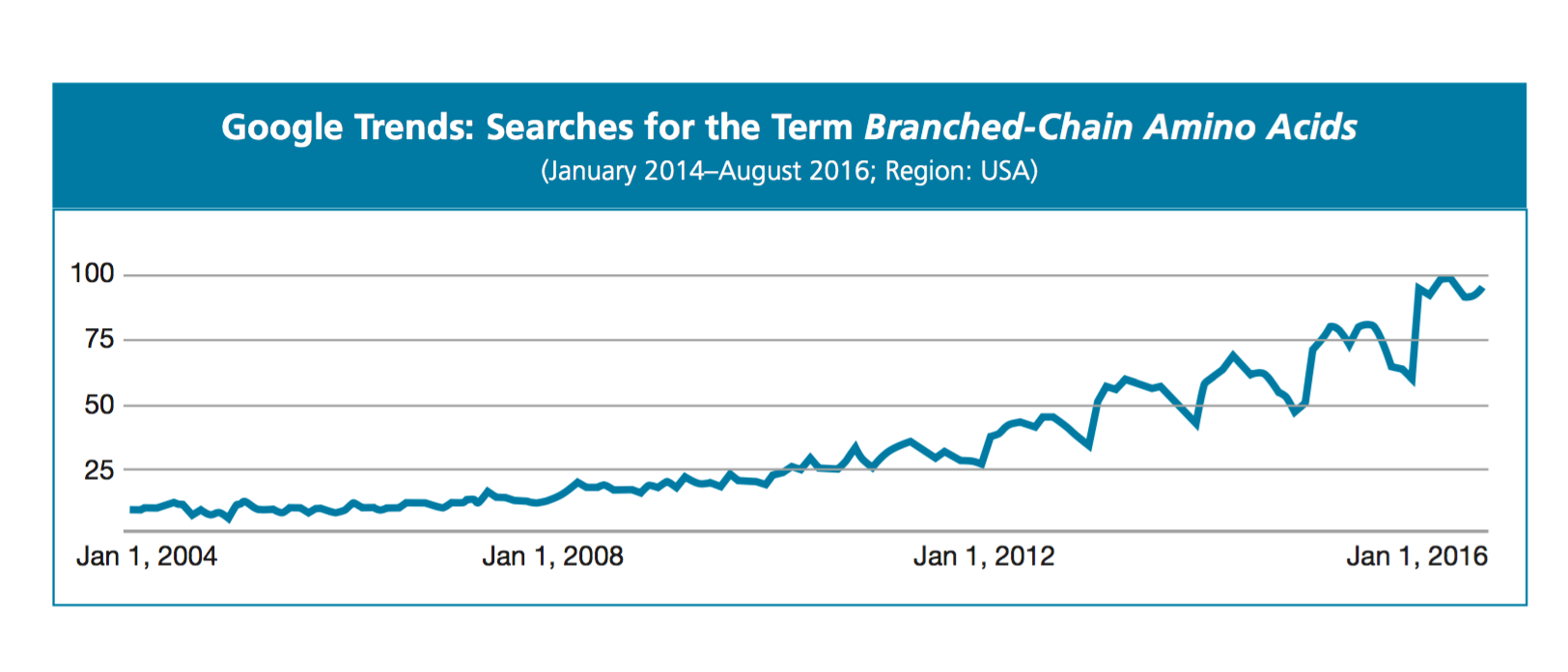What Google Trends Says about Branched-Chain Amino Acids
Google Trends confirms that consumer understanding of branched-chain amino acids is more advanced than ever before.

Thanks to the Internet, we can gain a better understanding of almost anything these days. Market trends are no exception, including those in the world of sports nutrition.
In the sports market, one acronym currently ranks above the rest: BCAA. Short for branched-chain amino acids, these uniquely structured amino acids have worked their way-one powder product at a time-into the sports nutrition spotlight. With the help of Google (and, more specifically, Google Trends), we can gain some valuable insight into consumer interest in BCAAs and predict what may be next for these exceptional amino acids.
Recognizing the Larger Trend
Google Trends (www.google.com/trends) is a search platform that allows users to see how certain Internet search terms are trending. Through Google Trends, for instance, we can discover that turmeric is a “rising star” (as Google calls it), sitting among some of the most-searched food words in 2016. Even though BCAA isn’t at the level of a “rising star,” Google Trends still reveals that interest in the term is high-and growing.
Taking a look at the past decade, even though interest in the term BCAA did start to climb by mid-2008, according to Google’s “Interest over Time” report, the surge in interest over the last five years has been nothing less than tremendous. From August 2011 through August 2016, interest in the search terms BCAAs and branched-chain amino acids grew at an average rate of 22% each year. What’s more, this quantifiable (not to mention impressive) surge in interest has shown no sign of slowing as we work our way into 2017.
Digging Deeper with Related Queries
Perhaps even more useful than data on a certain single term (e.g, BCAA), Google Trends also provides insight on search queries for terms related to the primary search term (such as best BCAA or BCAA for women). Among those related queries, users can view the top “rising” related queries (those that have seen the most significant increase in search volume).
If we review the last 12 years’ worth of search queries related to BCAAs, an interesting trend starts to emerge. To simplify things, let’s break the last 12 years into three windows, with each window covering a four-year span.
January 2004–January 2008: Google’s query data is relatively scarce over this time frame, which shouldn’t come as much of a surprise given the fact that from 2004 through mid-2008, user interest in BCAAs was at its lowest recorded (barely breaking double-digit interest). The search terms recorded as “rising” and “breakout” were nothing if not basic and included the simple queries branched-chain amino acid and BCAA.
January 2008 – January 2012: The number of related queries increased significantly during this time. Google was able to provide data on more than 20 related queries, and they included more specific phrases and questions about BCAAs, including BCAA benefits, best BCAA supplement, and BCAA side effects.
January 2012–January 2016: In the final leg, the nature of consumer interest in BCAAs appears to have shifted. Search terms consisted almost exclusively of terms and phrases related to branded BCAA products. While the questions and phrases concerning the BCAA basics are still some of the top related queries, almost all of the “rising” and “breakout” queries are brand- or product-specific.
Why did this shift in behavior happen? It’s simple. As demand and interest in BCAAs increased, so did the willingness of users, supplement takers, and supplement industry insiders to learn about BCAAs. As consumer awareness of BCAAs and their benefits reached the “common knowledge” levels of today, it follows that the nature of the conversation has shifted from “What are they, and how do they work?” to “Of all the different BCAA products out there, which one is best suited to meet my unique needs?”
What’s Next for BCAAs?
If current trends hold, BCAAs will maintain their place in the sports supplement spotlight into 2017 and well after. It looks as though the mindset of the BCAA market going forward will continue to be an increasingly product-centric one.
With the help of the Internet, social media, and digital media, consumers will likely spend more time seeking to understand the differences between BCAA brands, formulations, and delivery methods. For brand owners and manufacturers, this means finding more new and acceptable methods for distinguishing their BCAA products from the thousands of others that are currently on the market.
Melissa DellaBartolomea is a content marketing specialist and writer for NutraScience Labs (Farmingdale, NY), a subsidiary of Twinlab Consolidation Corp.
Also read:
Google Calls Turmeric a Rising Star
Staying Ahead of the Game: Sports Nutrition Market Trends for Dietary Supplements, Food, and Drinks
Sports Supplement Ingredient Trends

Prinova acquires Aplinova to further increase its footprint in Latin America
April 7th 2025Prinova has recently announced the acquisition of Brazilian ingredients distributor Aplinova, which is a provider of specialty ingredients for a range of market segments that include food, beverage, supplements, and personal care.

























